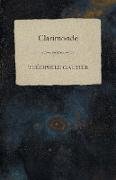Pierre Jules Théophile Gautier (/go¿'tje¿/;[1] French: [pj¿¿ ¿yl teofil gotje]; 30 August 1811 - 23 October 1872) was a French poet, dramatist, novelist, journalist, and art and literary critic.
While an ardent defender of Romanticism, Gautier's work is difficult to classify and remains a point of reference for many subsequent literary traditions such as Parnassianism, Symbolism, Decadence and Modernism. He was widely esteemed by writers as disparate as Balzac, Baudelaire, the Goncourt brothers, Flaubert, Pound, Eliot, James, Proust and Wilde.
Gautier was born on 30 August 1811 in Tarbes (France), capital of Hautes-Pyrénées département (southwestern France). His father was Jean-Pierre Gautier,[2] a fairly cultured minor government official, and his mother was Antoinette-Adelaïde Cocard.[2] The family moved to Paris in 1814, taking up residence in the ancient Marais district.
Gautier's education commenced at the prestigious Collège Louis-le-Grand in Paris (fellow alumni include Voltaire, Charles Baudelaire, Victor Hugo, and the Marquis de Sade), which he attended for three months before being brought home due to illness. Although he completed the remainder of his education at Collège Charlemagne (alumni include Charles Augustin Sainte-Beuve), Gautier's most significant instruction came from his father, who prompted him to become a Latin scholar by age eighteen.
While at school, Gautier befriended Gérard de Nerval and the two became lifelong friends. It is through Nerval that Gautier was introduced to Victor Hugo, by then already a well-known, established leading dramatist and author of Hernani. Hugo became a major influence on Gautier and is credited for giving him, an aspiring painter at the time, an appetite for literature. It was at the legendary premiere of Hernani that Gautier is remembered for wearing his anachronistic red doublet.
In the aftermath of the 1830 Revolution, Gautier's family experienced hardship and was forced to move to the outskirts of Paris. Deciding to experiment with his own independence and freedom, Gautier chose to stay with friends in the Doyenné district of Paris, living a rather pleasant bohemian life.
Towards the end of 1830, Gautier began to frequent meetings of Le Petit Cénacle (The Little Upper Room), a group of artists who met in the studio of Jehan Du Seigneur. The group was a more irresponsible version of Hugo's Cénacle. The group counted among its members the artists Gérard de Nerval, Alexandre Dumas, père, Petrus Borel, Alphonse Brot, Joseph Bouchardy and Philothée O'Neddy (real name Théophile Dondey). Le Petit Cénacle soon gained a reputation for extravagance and eccentricity, but also for being a unique refuge from society.


